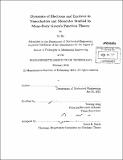Dynamics of electrons and excitons in nanoclusters and molecules studied by many-body Green's function theory
Author(s)
He, Yi, Ph. D. Massachusetts Institute of Technology
DownloadFull printable version (11.80Mb)
Other Contributors
Massachusetts Institute of Technology. Dept. of Mechanical Engineering.
Advisor
Taofang Zeng.
Terms of use
Metadata
Show full item recordAbstract
The development of efficient and economic photovoltaic (PV) systems harvesting solar energy is one of the grand challenges for engineering and scientific researchers. The theoretical conversion limit of a single-junction solar cell is 31% according to Shockley and Queisser (SQ), which the most advanced single-junction PV devices are approaching. Thus it is important to develop new methods and devices that can exceed the SQ limit. An economic strategy that may potentially break the SQ limit is to make use of the unique properties of semiconductor nanoclusters to fabricate PV devices. The physics of semiconductor nanoclusters such as the dynamics of electrons and excitons are the fundamentals for fabricating nanocluster-based PV devices. Although the theories and numerical approaches have been long established for three-dimensional (3D) bulk materials, two-dimensional (2D) graphene-like structures and one-dimensional (ID) nanotubes, the computational methods for zero-dimensional (OD) finite systems based on the most advanced physical theory are not well established. In the thesis, the computational approaches and methods based on the many-body Green's function theory are developed for OD nanoclusters and molecules. The numerical implementations for the calculation of electronic inelastic scattering rates in nanoclusters are established. An efficient computational approach for the calculation of excitonic inelastic scattering rates in nanoclusters is also developed. Both the single-phonon and the multiple-phonon nonradiative relaxation mechanisms in nanoclusters are investigated. It is demonstrated that the nonradiative relaxation of one-particle states and two-particle states are distinctive due to the difference between the density-of-states of one-particle states and two-particle states. Based on the numerical method established in the thesis, a strategy is proposed to reduce the electron-phonon coupling in nanoclusters by pushing valence electron away from nuclei with core electrons in heavy atoms, which is demonstrated with the lead chalcogenide nanoclusters, and porphyrin molecule and a porphyrin derivative.
Description
Thesis (Ph. D.)--Massachusetts Institute of Technology, Dept. of Mechanical Engineering, 2012. Cataloged from PDF version of thesis. Includes bibliographical references (p. 147-150).
Date issued
2012Department
Massachusetts Institute of Technology. Department of Mechanical EngineeringPublisher
Massachusetts Institute of Technology
Keywords
Mechanical Engineering.